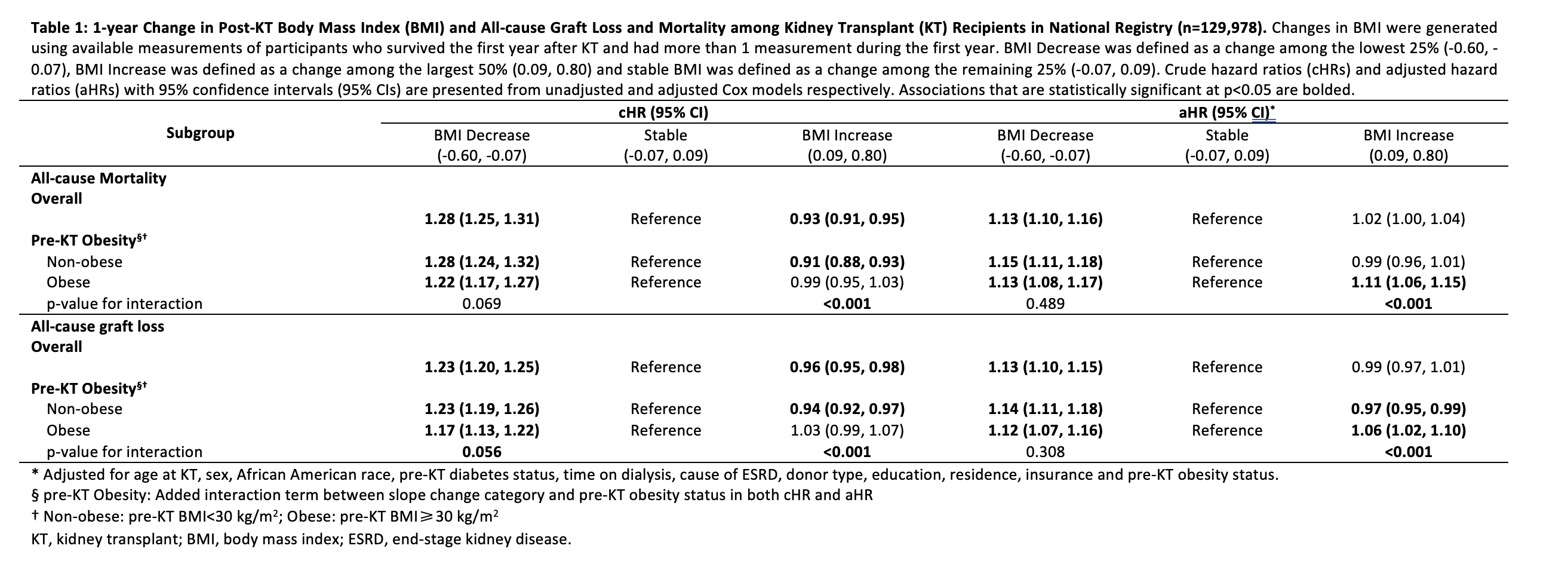Post-Kidney Transplant Body Mass Index Trajectories Are Associated with Graft Loss and Mortality
Y. Liu1, V. Bendersky1, X. Chen1, M. Harhay2, D. Segev1, M. McAdams-DeMarco1
1Johns Hopkins University, Baltimore, MD, 2Drexel University, Philadelphia, PA
Meeting: 2022 American Transplant Congress
Abstract number: 769
Keywords: Graft failure, Kidney transplantation, Mortality, Obesity
Topic: Clinical Science » Kidney » 35 - Kidney: Cardiovascular and Metabolic Complications
Session Information
Session Name: Kidney: Cardiovascular and Metabolic Complications
Session Type: Poster Abstract
Date: Saturday, June 4, 2022
Session Time: 5:30pm-7:00pm
 Presentation Time: 5:30pm-7:00pm
Presentation Time: 5:30pm-7:00pm
Location: Hynes Halls C & D
*Purpose: Early post-kidney transplantation (KT) changes in physiology, medications, and health stressors likely impact body mass index (BMI). Hence, we sought to estimate trajectories of post-KT BMI and quantify the association between 1-year post-KT BMI change and long-term graft loss and mortality.
*Methods: Using SRTR, we estimated 5-year post-KT (n=151,170) BMI trajectories using an adjusted mixed effects model. We then estimated 1-year post-KT BMI change using unadjusted linear regression models defining BMI change by quartile [decrease (1st quartile): change<-0.07 kg/m2/month; stable (2nd quartile): -0.07≤change≤0.09 kg/m2/month; increase (3rd and 4th quartile): change>0.09 kg/m2/month]. We estimated mortality and graft loss risks by BMI change using adjusted Cox proportional hazards models.
*Results: BMIs increased in the first 3 years post-KT (0.65 kg/m2/year, 95% CI: 0.65, 0.66) and decreased in years 3-5 (-0.25 kg/m2/year, 95% CI: -0.26, -0.24). 1-year post-KT BMI decrease was associated with elevated risks of mortality (aHR=1.13, 95% CI: 1.10, 1.16) and graft loss (aHR=1.13, 95% CI: 1.10, 1.15) regardless of pre-KT obesity status. Among obese recipients (pre-KT BMI≥30kg/m2), BMI increase was associated higher mortality (aHR= 1.11, 95% CI: 1.06, 1.15) and graft loss (aHR=1.06, 95% CI: 1.02, 1.10) risks, relative to stable BMI. Among the non-obese, BMI increase was associated with lower graft loss (aHR=0.97, 95% CI: 0.95, 0.99) but not mortality risk (aHR= 0.99, 95% CI: 0.96, 1.01). The results remained robust in sensitivity analysis.
*Conclusions: BMI increases in the 3 years post-KT then decreases in years 3-5. BMI loss in all KT recipients and BMI gain in those with obesity should prompt more granular clinical risk assessments.
To cite this abstract in AMA style:
Liu Y, Bendersky V, Chen X, Harhay M, Segev D, McAdams-DeMarco M. Post-Kidney Transplant Body Mass Index Trajectories Are Associated with Graft Loss and Mortality [abstract]. Am J Transplant. 2022; 22 (suppl 3). https://atcmeetingabstracts.com/abstract/post-kidney-transplant-body-mass-index-trajectories-are-associated-with-graft-loss-and-mortality/. Accessed December 24, 2025.« Back to 2022 American Transplant Congress

